How can you turn this to your advantage?
An increasing number of companies are exploring ways to turn their parking lots into profitable assets. They are often intrigued by the idea of converting parking spaces into solar canopies. However, many of these potential solar canopy customers have common questions and concerns. They want to know about the design of these structures, the optimal number of charging systems for electric cars, how to utilize excess solar energy production, the space required for external battery containers and inverters, the amount of soil that needs to be excavated for installation, and the potential impact of one module malfunctioning on the rest of the system.
Furthermore, the perspective of electric vehicle users is important in this discussion. They often ponder, “Where can I conveniently charge my electric vehicle?” Many don’t have the space for home charging, find commercial chargers expensive, and lack a garage for this purpose.
This presents a remarkable opportunity for parking lot owners and management companies to transform their spaces into valuable assets. It encourages individuals who lack access to home or workplace charging options or those looking to avoid the cost of installing a charger at home to consider alternative services.
Time is an invaluable resource, and at Tonomia’s eParking Solar, we firmly believe in optimizing it. Why not empower your employees or customers to charge their electric vehicles right in the parking lot while they work or shop for groceries? This convenience is available whenever your vehicle is parked, whether you’re at the office, train station, attending an exhibition, or even during a hospital visit. The possibilities are limitless.

Shopping centers, exhibition venues, and parking management firms are actively exploring ways to attract more customers and encourage longer and more frequent visits. Currently, paid parking lots struggle to generate significant profits, while free lots drain valuable resources. What if the pricing per kilowatt-hour (kWh) could vary throughout the day? How can we turn these parking facilities into profitable ventures?
Electricity distribution operators, or GRIDs, are grappling with the growing challenge of network congestion caused by the proliferation of renewable energy producers. They seek solutions to efficiently transport excess energy generated by these new renewable sources from residential areas to businesses. eParking offers a solution: why not store surplus energy for later use or produce it during off-peak hours when costs are lower? Owners of photovoltaic panels also face grid congestion issues, as their inverters may stall when solar production outpaces consumption.
Public and local authorities are contemplating strategies to promote electric mobility and boost local business foot traffic simultaneously. They ponder how to address the risks associated with fluctuating electricity prices or how to harness cheap or even free electricity. Is energy storage now a profitable endeavor?
In an era of increasing water scarcity and rising costs, preserving this precious resource becomes paramount. Rainfall on concrete parking lots often goes to waste. How can we effectively collect and locally utilize this water resource?
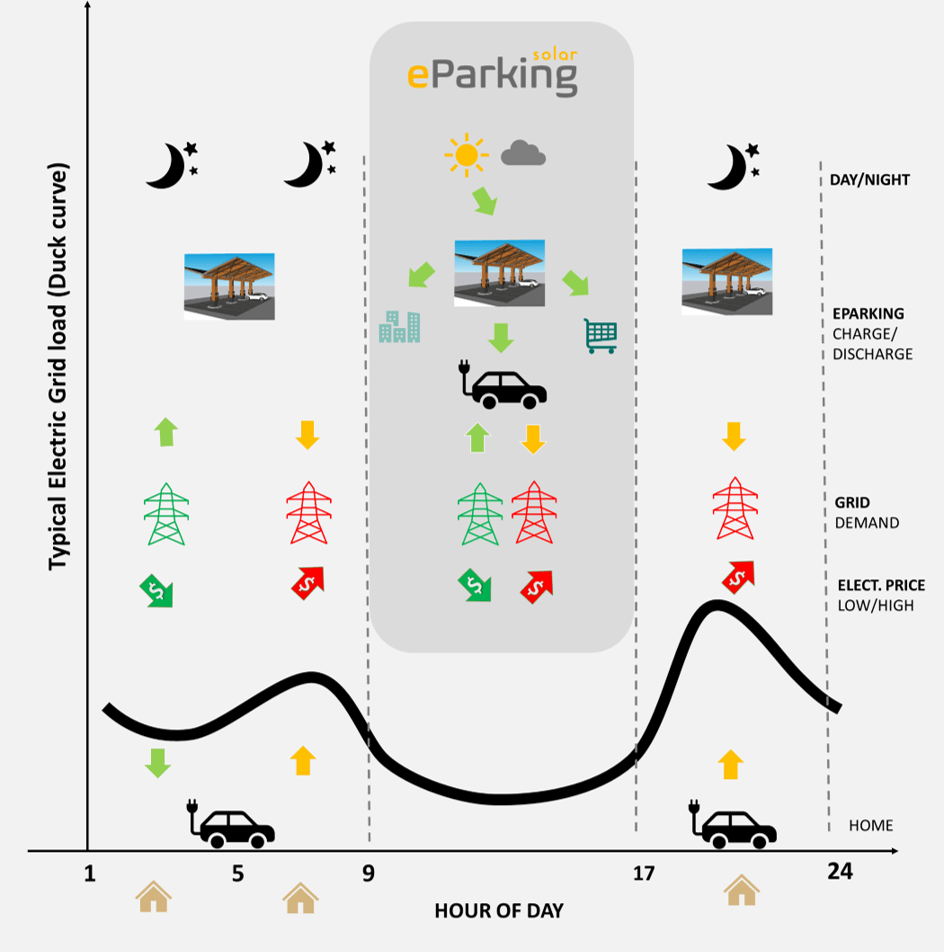
The Solution
eParking Solar presents a comprehensive suite of solutions tailored to the ever-evolving needs of individuals and businesses interested in harnessing solar energy.
Our inspiration for designing, ensuring quality, and prioritizing operational safety for eParking modules draws from the automotive industry’s innovation. These cutting-edge solar car park modules are patented and come in the form of solar carports, complete with or without charging facilities, accommodating 1, 2, 3, or 4 electric vehicles, depending on the charger type integrated into the pillar structure. The distinctive Y-shaped canopy is constructed using photovoltaic panels equipped with batteries, seamlessly storing the electricity generated by the solar carport’s panels or sourced from the public grid. Installation is swift and straightforward, requiring no soil excavation. Furthermore, our units are delivered 80% assembled, enabling you to start saving money almost immediately.
eParking seamlessly integrates with all electric vehicle charger reservations and payment networks, offering a flexible and convenient solution for all.
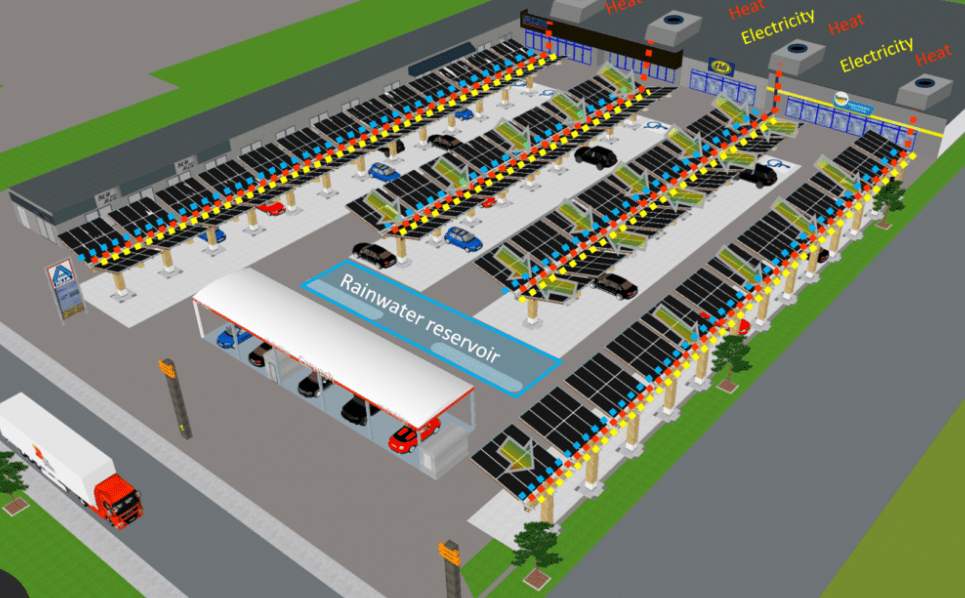
All-in-one smart solar eParking module:
- Electricity
- Heat
- Storage
- Fast charging
- Thermal cameras monitoring the quality of solar panels
- Self-cleaning solar panel system
- Intelligent E-Box for Module System Control
- Wi-Fi and 4G/5G connectivity
The modules, designed for either 2 or 4 parking spaces, come in the shape of a Y-infrastructure for 4 parking spaces or a ½ Y-infrastructure for 2 parking spaces. The primary supporting pillar is a hybrid structure, combining wood and metal, featuring a rainwater reservoir that collects all the precipitation gathered by the photovoltaic panels. This harvested water serves multiple purposes, such as cooling the storage batteries, automatically cleaning the solar panels, and can be distributed to various locations, including parks, restrooms, car washes, and other electricity-consuming facilities.
The photovoltaic panels deliver an impressive output of 10 kWp, covering an area of approximately 46 m² for 4 parking spaces and nearly 23 m² for a module accommodating two parking spaces. This energy production translates into an estimated annual generation of 10 MWh, equivalent to the power consumption of 2.5 households.
The eParking solar carport module is seamlessly integrated, eliminating the need for bulky external battery containers that might otherwise occupy space designated for additional parking spots. Within the central pillar, the batteries are cleverly integrated, capable of storing the energy equivalent to the consumption of 15 households (any surplus energy beyond panel production is drawn from the grid) or accommodating the charging needs of 30 electric vehicles daily.
This unit incorporates a 30 kW inverter, effectively managed by the batteries and their individual charging capacities, facilitated by an advanced Battery Management System. The batteries can be charged either through the power generated by the photovoltaic panels or via the public grid (GRID). A common concern with photovoltaic panels is the risk of inverter shutdown during grid congestion. To mitigate this, we’ve adopted an innovative approach, optimizing electricity supply. Stored energy is intelligently distributed to all interconnected modules, ensuring the reliable operation of electric vehicle chargers, thereby guaranteeing the availability of electricity for each EV’s charging needs.
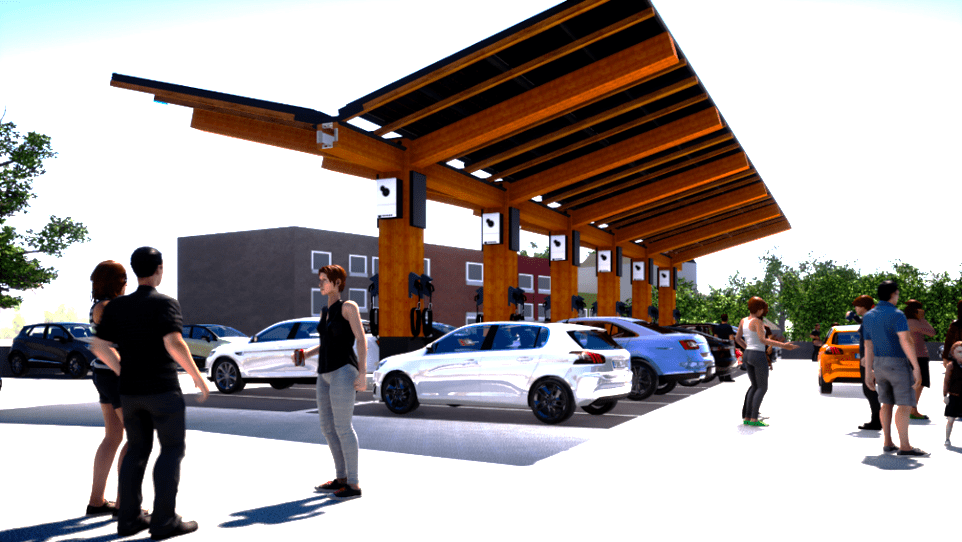
The compact, liquid-cooled chargers operate silently, delivering a consistent current.
The potential capacity of an eParking module, designed for 4 parking spaces, varies depending on the number of parked vehicles. It can be configured for 4 cars charging at 30 kW (when all 4 parking spaces are occupied), 2 cars at 60 kW (with 2 parked vehicles), or 1 car at 120 kW (for a single parked vehicle).
In Northern Europe, a single 4-space module can collect an estimated 40 m³ of water, equivalent to the capacity required for 200 car washes within the same parking area.
During the mid-season and summer, the solar panels generate heat, which can be efficiently captured through ducts beneath the photovoltaic panels. This heat can then be utilized, thanks to interconnections between modules, to warm the air using a heat pump.
Lastly, the entire eParking Solar structure is supported by a partially buried base anchored with 4 high-pressure-driven anchors into the ground. This base also serves as a protective buffer, preventing any inadvertent damage to the structure or vehicles by electric vehicle drivers.

What is a smart solar car park ?
At the core of each eParking module, we have the TonoBox, an intelligent unit driven by artificial intelligence. Its primary role is to oversee and manage the electronic components, guaranteeing the system’s uninterrupted functionality. The presence of a dedicated TonoBox for each module ensures that any issues with one module do not pose a risk of causing a complete system failure.
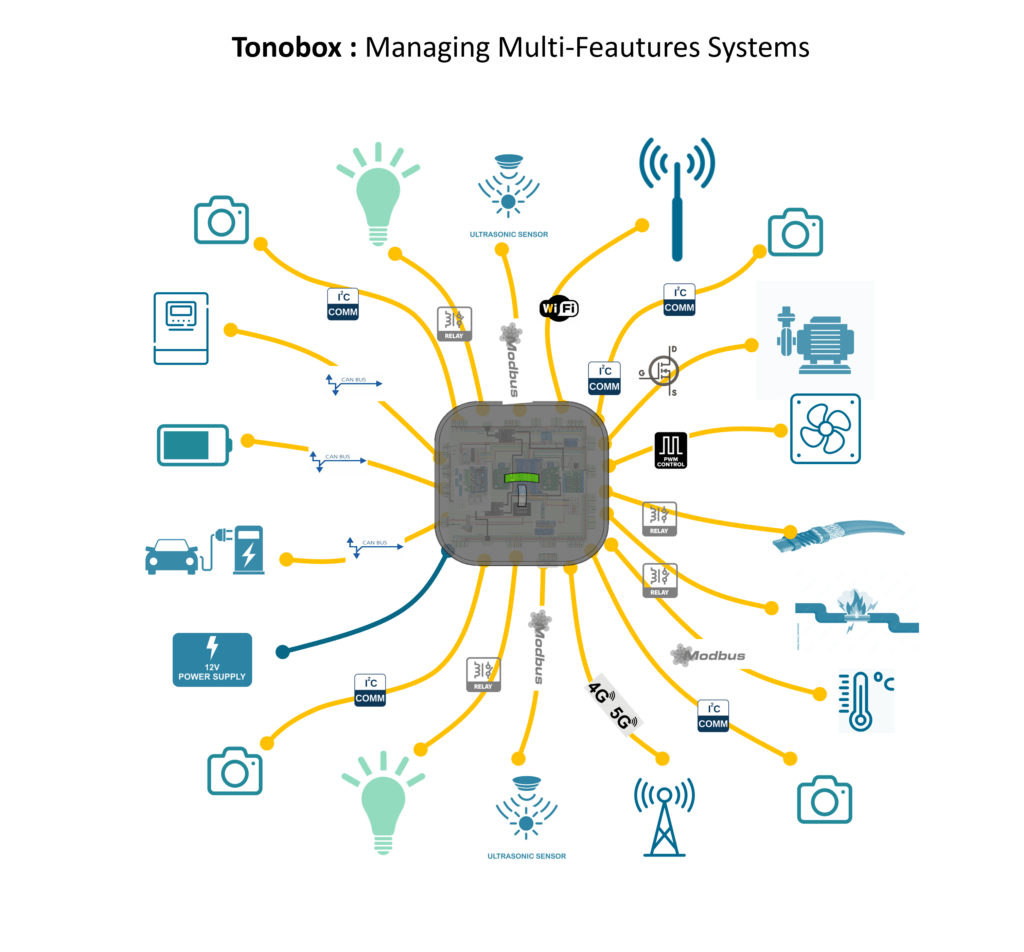
Why is the TonoBox of eParking solar unique?
In terms of operation, monitoring, and fire safety, eParking Solar employs a cutting-edge central management system, meticulously overseeing each module and system individually. This centralized control is facilitated through our custom-designed solar box.
This smart box is equipped with redundant computers, featuring Twin Raspberries, and comes with additional connectors, supporting a total of 8 distinct control and communication protocols.
- CAN bus
- Modbus
- I2C
- Relay Control
- Mosfet Control
- PWM Signal
- WiFi
- 4G/5G
The “All-in-One” module for monitoring & control
The eParking solar smart module represents a cutting-edge, all-in-one solution with patents covering over 250 distinct and specific features. This comprehensive solution seamlessly incorporates 25 subsystems, including elements such as electricity, heat management, hydraulics, sodium-ion battery storage, direct current fast charging, and advertising displays, among others.
Remarkably, 16 out of these 25 subsystems are exclusive innovations unique to eParking, setting our solution apart. In the design of the eParking module, we’ve taken into account a total of 28 outdoor systems, ensuring a truly integrated and versatile approach.
The Tonomia smart box contains two onboard redundant microprocessors, offers both Wi-Fi and 4G/5G connectivity, and precisely controls all the above subsystems. The redundant microprocessors ensure uninterrupted operation for 30 years.
The eParking solar smart module excels in reliability, thanks to its incorporation of four thermal imaging cameras that maintain continuous surveillance and ensure seamless operations. While bird waste poses a frequent issue for numerous solar panel installations, leading to thermal incidents, our system remains immune to such concerns. The thermal cameras diligently scan for birds and any unwelcome visitors, promptly triggering an ultrasonic noise to deter intruders upon detection.

Durability
You might have come across news regarding fires resulting from subpar wiring and connectors in solar installations. At eParking, we maintain a strict policy requiring our collaborators to conduct thorough roof inspections of photovoltaic installations. This ensures that all work adheres to our rigorous standards before the system is activated. Moreover, we have implemented a fire detection feature in addition to a self-cleaning water-based system, which effectively maintains the system’s temperature and prevents overheating.
The rainwater tank serves a dual purpose of cooling or heating batteries and cleaning solar panels. Beyond its structural role, the rainwater collection reservoir (tube) is equipped with a heating cable that prevents freezing in winter while warming the batteries, and it also includes a water pump to maintain cooling during summer nights.
Maximize the potential of your parking facility.
That’s why we’ve implemented an ultra-compact, high-speed charging system. Every inch of space is put to good use. Our charging system is modular, ranging from 30 kW to 120 kW. It connects directly to the module batteries, eliminating the need for AC-DC conversion, ensuring exceptional efficiency. Both the inverter and the fast-charging system are conveniently housed within the main pillar, depicted in green in the image.
The next generation of sustainable battery
Equipped with Sodium (or Lithium) batteries with a capacity of up to 150 kWh, an eParking module allows self-consumption and can even store the equivalent of the daily consumption or photovoltaic production of 15 houses.
A parking lot in a commercial area has the capacity to store energy equivalent to the consumption of 3,000 houses.
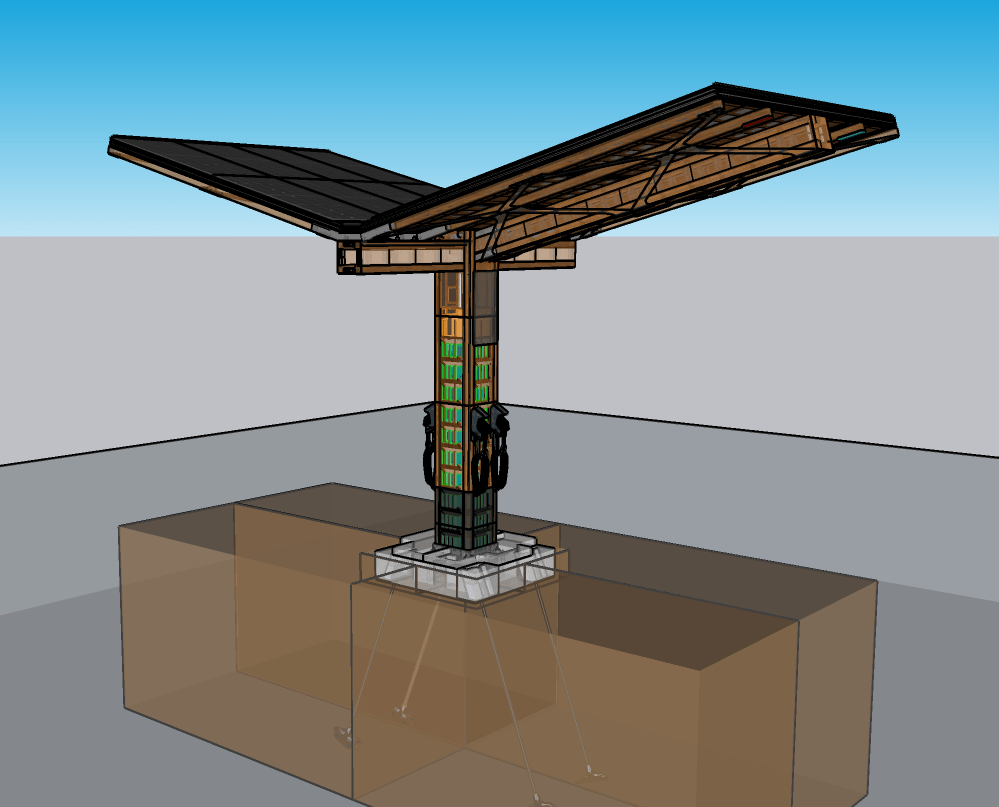
The modular, partly pre-assembled design, eParking solar installation is quick and easy
What are the possible architectures and the milestones about the feasibility (site design), installation & commissioning phases?
However, there is a granularity for EV charger capacity and Na ion battery capacity choice for installation, for each individual module.
No conventional solution on the market offers a similar granularity
The pre-packed modules in a container are ready for easy transport (export) to wherever you need them.
A typical car park configuration
How can you preview the design of our modules on your parking lot?
We carry out a digital simulation of your parking lot
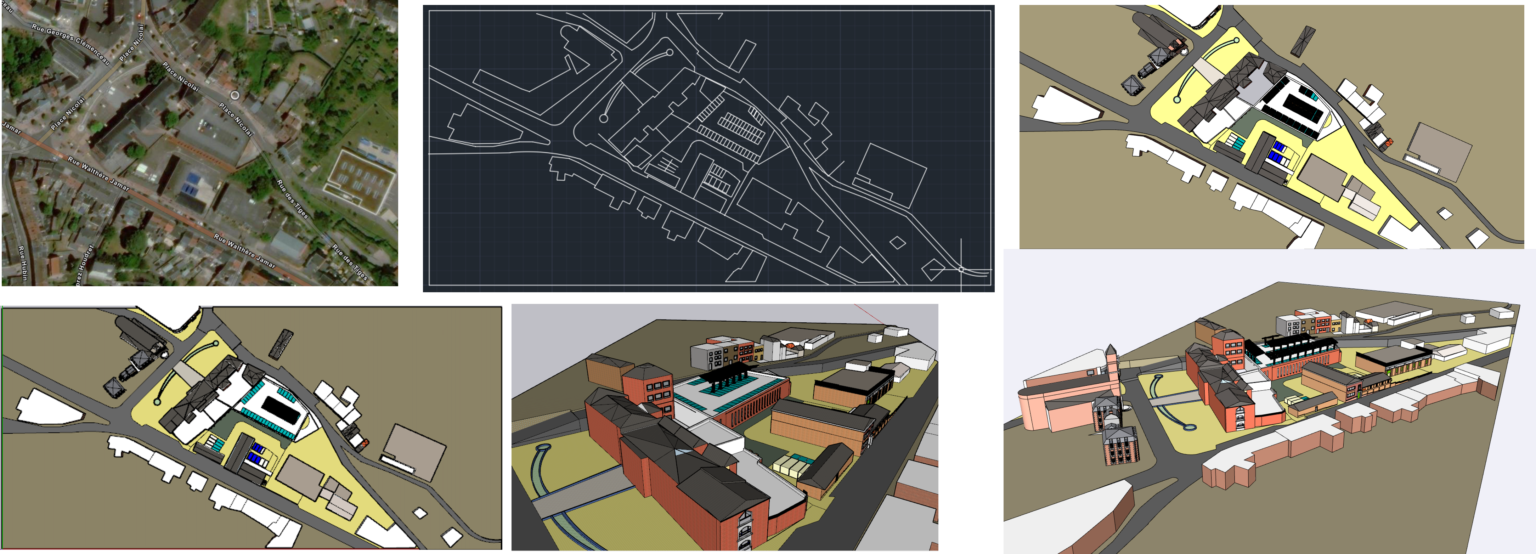
Assess for yourself how the eParking solar module designed for four cars excels when compared to other models available in the market:
In summary, here are ten compelling reasons why you should consider eParking modules for your parking facility:
- A solar-powered solution suitable for both average and large parking lots.
- Exceptional energy storage capabilities (40 kWh per parking space) and GRID balancing.
- Harnessing Artificial Intelligence (AI) through our TonoBox for enhanced quality and reliability.
- Embracing a holistic environmental approach, incorporating wood into the design.
- A comprehensive “all-in-one” system that showcases eParking’s uniqueness, featuring 250 specific innovations across 25 subsystems.
- Smart control with redundant microprocessors within our proprietary TonoBox.
- Innovative features ensuring top-notch quality and safety.
- A robust battery storage system for dependable performance.
- Ultra-compact charging for optimal efficiency and zero wasted space in your parking lot.
- Modular, flexible, and cost-effective design catering to both 2 and 4 parking spaces.
We are committed to sharing our vision of creating a more sustainable environment through parking lots. Our portfolio offers the solution to help you unlock the full potential of your parking facility, turning it into a profitable asset. Contact us today to explore how we can assist you on this journey.
|
|
System
|
Tonomia eParking
|
Competition
|
|---|---|---|---|
|
1
|
solar panels
|
|
|
|
2
|
Inverter
|
|
|
|
3
|
Meter
|
|
|
|
4
|
Battery
|
|
|
|
5
|
Breaker Pane
|
|
|
|
6
|
Thermal Cameras
|
|
|
|
7
|
EV charger DC\DC
|
|
|
|
8
|
ev charger controler
|
|
|
|
9
|
Disconnect Switches
|
|
|
|
10
|
Display Screen South
|
|
|
|
11
|
Power Cables and Connectors
|
|
|
|
12
|
Distribution Board
|
|
|
|
13
|
Grounding Equipment
|
|
|
|
14
|
Binders fasteners ( Concrete, screws)
|
|
|
|
|
System
|
Tonomia eParking
|
Competition
|
|---|---|---|---|
|
15
|
Vehicle Presence detectors
|
|
|
|
16
|
Human Presence detectors
|
|
|
|
17
|
Metallic Structure
|
|
|
|
18
|
Wooden Structure
|
|
|
|
19
|
Hot Air Ducting
|
|
|
|
20
|
Foundation by Anchorage
|
|
|
|
21
|
Water System
|
|
|
|
22
|
Self regulated heating cable
|
|
|
|
23
|
Fire detector
|
|
|
|
24
|
Insulation System
|
|
|
|
25
|
|
|
|
|
26
|
COM Cables and connectors
|
|
|
|
27
|
Protection (concrete plate)
|
|
|
|
28
|
Display Screen North & South
|
|
|
